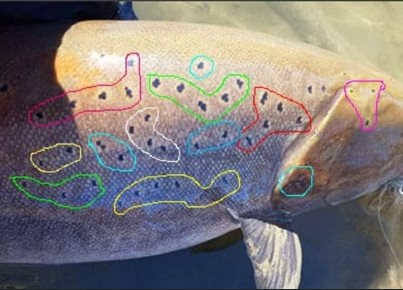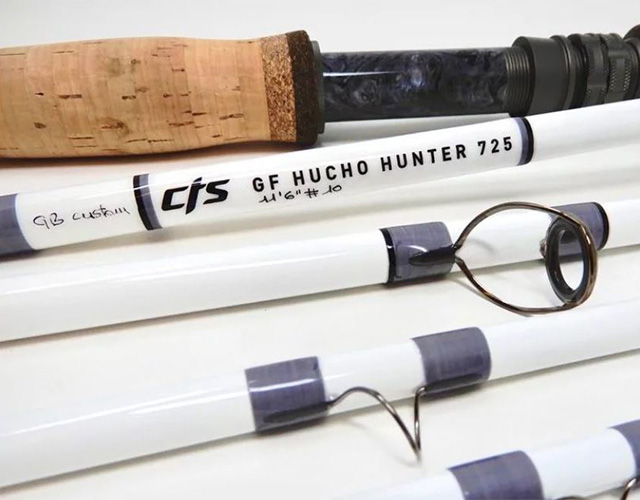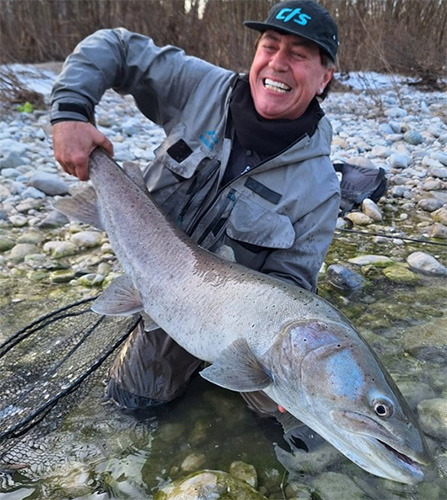Günter Feuerstein | April 2024
Another good huchen season has ended with many beautiful memories and a dozen fly-caught huchen.
If you have to drive 600 km to the next huchen water and can’t make a few quick casts after work when the huchen are active, every huchen caught on the fly is associated with a lot of satisfaction.
The joy is often accompanied by other valuable insights. I keep a detailed record of the huchen caught. The gill cover photos, which have a fingerprint character, can also be used to identify fish when they are recaptured.
I would like to mention two examples: A fellow guide from Bosnia sent me a photo of a huchen caught in January 2023. I caught the same fish in the same pool in October 2022. Unfortunately, I never got back in touch with a 120 cm huchen which I caught in 2019. Almost exactly three years later, a friend caught it at 128 cm in another area several kilometers away. The fish had probably changed its lay during the mega flood in 2019 because it had changed somehow. I know of several recaptures, including those by colleagues and acquaintances. “Our huchen have an eventful life,” as one of my huchen fishing friends aptly noted. In general, it can be said that huchen exceeding 1 m in length are usually caught no more than once or twice a year. Smaller huchen up to 80 cm may be caught more often in a season.

Long Rods are a Hindrance
Many fishermen contacted me during the season about my CTS GF Hucho Hunter huchen rod series. These rods are very powerful and, with a length of 11.6 feet, are ideal for fishing in confined spaces and getting close enough to the fish to land it on your own.
Some people preach using long rods for fishing with the mouse. In some situations, these allow you to control the mouse better, but require incomparably more space. With a few exceptions where this space is available, these rods cannot be used in many situations and without a colleague, it is difficult to get close to the fish when landing it or it takes a lot more time, which of course harms the fish. In addition, in some situations you have to fish the mouse very quickly, and the short rod is much more suitable for this.
Even if there are spots on large rivers that can be fished with a long rod, I generally consider two-handed rods over 12 feet to be less suitable for fishing for huchen with a fly. IMHO a rod length of 11.6 feet is absolutely perfect in terms of variability while fishing and advantages during the landing.

Avoiding Rod Breakage
Based on many conversations with fishing friends, clients and my own experience it can be summarized that rods broke almost exclusively for the following reasons:
The fisherman fished a line weight at the upper end of the grain window of his rod and did not take into account that the casting weight of the wet streamer must be added to the line weight when casting overhead, in contrast to casts that start from the water (water casts)! If you cast such a line in combination with a large wet streamer and a powerful overhead cast, the breakage is inevitable. Since the greatest load during extreme casts falls on the handle section, rods very often break in this area above the handle when overloaded because of a casting weight miscalculation. These breakages can also occur because a dealer mounts a line that is too heavy because he sells it to match the grain window, but does not know about the differences between overhead and water casts in connection with large streamers.
If you don’t care enough when fishing for large predators the joints of your double hand rod are the weak spots. In my opinion, most breakages are due to unconscious, but incorrect handling of the joints. When fishing for huchen with large streamers and lines exceeding 700 gr, rods are constantly exposed to extreme forces when casting. If you change locations very often when fishing for huchen and stow the rods in a warm car, the material expands during the journey. If you plug the joints together immediately after taking them out of the car while they are still warm, they can cool down rapidly within a short time. As the parts are of different thickness the time they cool down and contract is slightly different. As a result the connection might start to loosen slightly. If you walk along the riverbank with a mounted rod, you might accidentally get caught on branches of the riverbank vegetation. This may loosen the joints only imperceptibly, too. When you stop the rod during the following casts, the connection may continuously slip a little. If you don’t notice this because you’re not aware of the problem, your rod may break right at a joint. You can reduce the problem with the temperature change if you put the rod parts outside for 1-2 minutes before sticking them together. As soon as they reach the same temperature the joints should sit much better. But who really does that?
In order to avoid the regular checks and fish more carefree, I taped the joints with adhesive tape last season as I used to do when fishing for salmon many years back. I am sure that this would dramatically reduce the number of broken huchen fly rods – regardless of the manufacturer.
So, to be on the safe side, tape the joints of your double-hand rod when fishing for huchen. Your rod will thank you!
I hope you have lots of fun fishing for the smaller species now and by tying streamers for the next huchen season!





